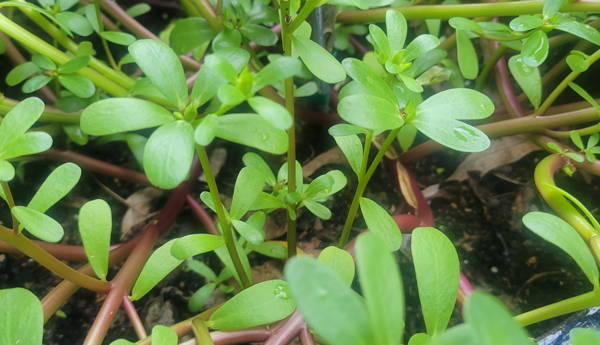
Purslane. I guarantee you’ve seen it, and if, like me, you grew up below the Mason-Dixon, you may even have heard of it by the slightly unappetizing moniker: Hogweed. Found growing wild across most of the United States, purslane is most definitely a weed, but the question is, is it a useful one? As you’ve probably guessed, given that we’re devoting an article to it, it is indeed. Read on for a few reasons why.
Easy Grower
For starters, as a weed, this is a very easy plant to grow and maintain. In fact, there is almost no maintenance required (just make sure it doesn’t overtake your other, more delicate plantings). Sporting red stems and small green leaves, I’ve heard folks call it wild watercress, and compare the flavor to spinach. As it turns out, the former is a pretty accurate description, being that the plant contains some 93-percent water.
Varieties
The type of purslane you are likely most familiar with is Portulaca Oleracea–the bright-green, wild-growing variant. With yellow flowers, its not exactly ugly, but be cautious putting it into your garden. The plant drops seeds when disturbed, so they can be a real bear to remove.
Golden purslane, or Portulaca sativa (yeah, yeah, I know what you’re thinking, hippie), is what you’ll usually find in an herb garden. Prized by chefs for giving dishes a Mediterranean flair, this sort of Purslane tastes like lemony spinach. This plant flowers during warm weather in the summer and fall.
Finally, there are two large groups of ornamental purslane , Portulaca grandiflora and Portulaca umbraticola. Steer clear of these, as they are strictly for decoration.
Uses
Clearly, purslane’s primary use is as a food. Stems and leaves can be used in salads, with other greens, or even farther afield, mixed in with your morning eggs. Pickling in apple cider vinegar, with some garlic and peppercorns for taste, is also an option. More than just a delicious accent, however, purslane has some pretty impressive health benefits.
For starters, a single cup of purslane 1.74-percent daily value of protein (%DV), 2.8%DV of Calcium, 10.75%DV of Iron, 4.51%DV of Potassium and 2.71%DV of Phosphorous. It does not stop there, however. Purslane also contains Vitamin B1, B2, B3, B6,and B9 (in amounts ranging from 1.25%DV to 3.69%DV), and a whopping 10%DV of Vitamin C. So clearly this herb does not just resemble spinach in taste, it resembles it in health benefits too.
This has long been known around the world, and particularly in the Mediterranean and Asian countries where its use was first promulgated. In addition to its use there as a potherb (soup flavoring), it was traditionally used to treat burns (in salve form), headaches and stomach ailments. Some other cultures even went further, using it to treat liver conditions, shortness of breath and arthritis. More modern uses find it helps with conditions like psoriasis and osteoporosis.
Foraging
The easiest way to secure purslane, of course is by planting it in your garden, but what if you want to find some in the wild, the old-fashioned way? Luckily for you, the stuff can be found growing just about anywhere. Stems are smooth and red, while leaves are green and flat. If you get lucky, you’ll see yellow flowers, but these are rare, and really only open on sunny days (and will not even appear without sufficient rainfall). As usual, look up some photos, and NEVER eat anything in the wild unless you are absolutely sure you know what it is.
A humble homesteader based in an undisclosed location, Lars Drecker splits his time between tending his little slice of self-sustaining heaven, and bothering his neighbors to do his work for him. This is mainly the fault of a debilitating predilection for fishing, hunting, camping and all other things outdoors. When not engaged in any of the above activities, you can normally find him broken down on the side of the road, in some piece of junk he just “fixed-up.”

Valerie Haynes says
Be sure you don’t plant giant hogweed. It can be very dangerous with the potential to burn, scar and even blind you with its sap:
seagrant.sunysb.edu/ais/pdfs/GianthogweedFactsheet.pdf
Dennis says
We never knew what this was until recently.It grew wild all over our garden area. We thought it was a weed. We pulled it and threw it out. It always comes back.We are going to try some next year. Thanks for the article. We live in northern Calif. Above SanFrancisco.
CaptTurbo says
Tony, at lest in my area (SW Florida) the stuff is growing out of cracks in the sidewalk. It’s everywhere! I have much of my lot dedicated to growing food so I allow purslane to grow wherever it wants. Plenty of it here. Been eating the stuff for years! One thing I didn’t notice in the article and perhaps the most important reason to grow and eat purslane is that it contains a lot of the Omega 3 oils.
Fred says
Here near the ocean, P oleracea tastes salty. It grows well in the sand and is easy to pull up. I pull up the flowering plants, carefully cut off the roots and brush off any sand or dirt and put the whole plants in a brown paper bag overnight. They drop their small black seeds and these may be planted, refrigerated, or used in place of poppy seeds. I pickle the red stems and discard the woody ones.
Tony soto says
Hey Lars, I’ve seen this in many locals but am not sure of the good ones. Can I buy seeds or plants and what do I look for?